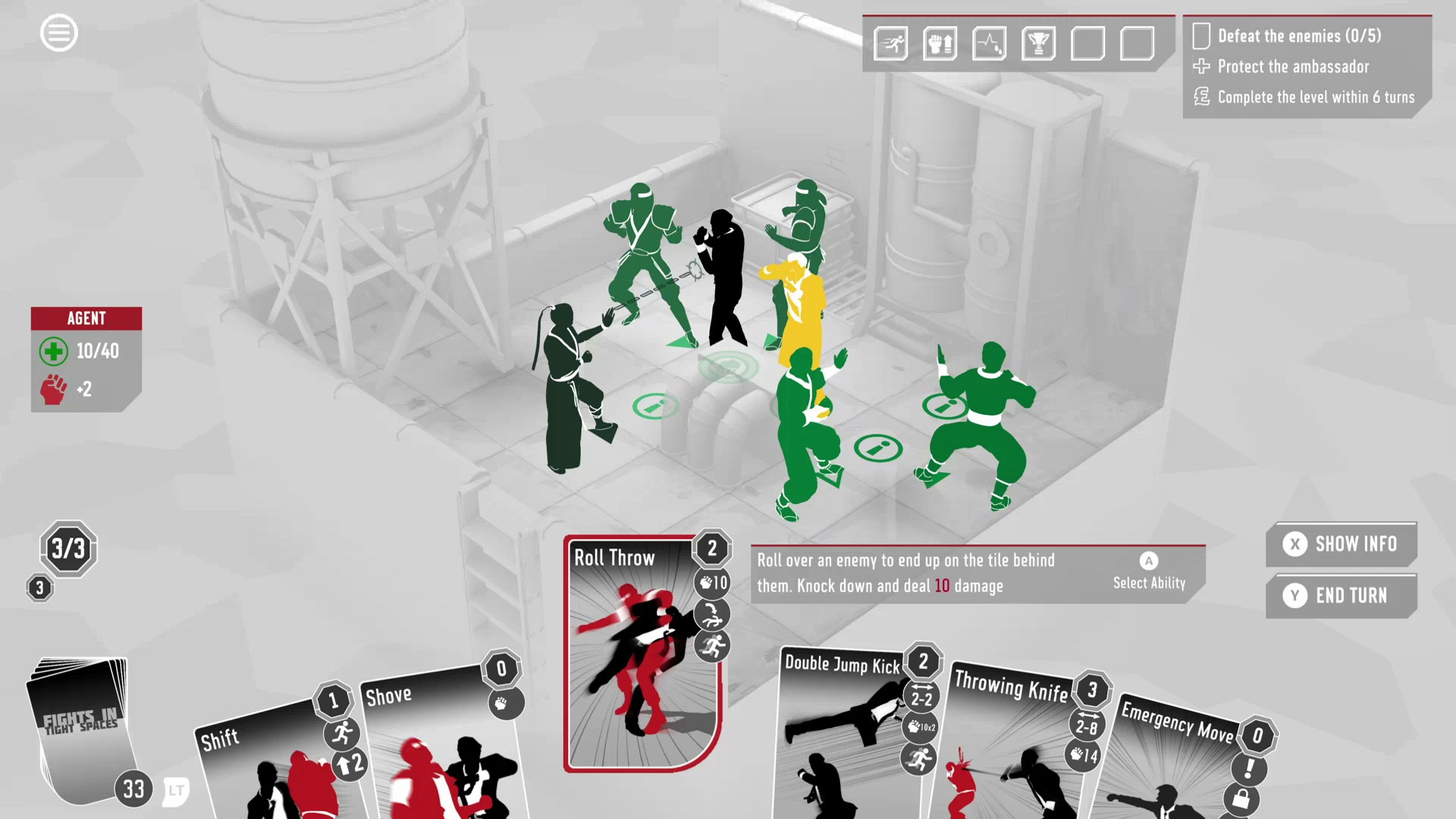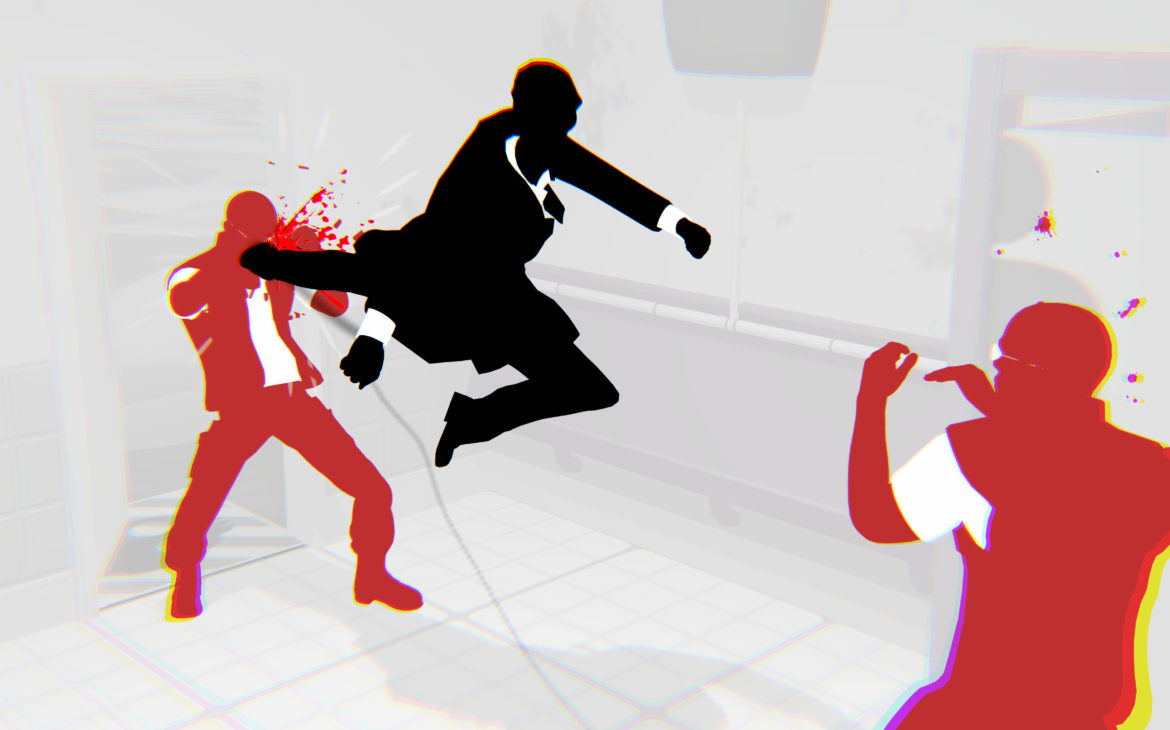A fantastic blend of roguelike, turn based strategy and deck build card games, Fights In Tight Spaces is a dark horse GOTY contender. The Finger Guns Review.
My Agent 11 is facing off against a chunky biker boss and a pair of his pistol wielding minions. I’ve messed up and I’m cornered. Both the minions have me in their crosshairs and my only path out is blocked by the boss. My poor decisions up to this point have meant that I’ve been dealt a “Deadly Deal” injury which means I lose 3 health with each new turn (in exchange for a full health bar at the start of each fight). This fight has been going for so long, and I’ve made so many mistakes, I’ve only got 4 health left. If the next set of cards drawn aren’t in my favour, this is likely my last turn. The cards filter on to the screen and my heart sinks. I’m done for. I can’t see a way out. Only 2 of the cards deal damage and the boss still has plenty of his health remaining.
But then I see it. I play a card and slip behind the boss. I’m out of the corner but that won’t do. I’ve got to finish this off now. I push the boss. We’ve switched places and he’s now in a crossfire from his own goons. I’ve got one action left so I kick him into the wall. My kick hurts him, but so does his collision with the wall. End turn. The minions, already committed to firing their weapons, let loose. Shot. Shot. The boss falls. I win. I get up off the couch and do a little dance in the living room, much to the confusion of my wife. Sure, I died a few levels later, but for a brief moment, I was Jason Statham.
Your mission, should you choose to accept it…
Fights In Tight Spaces is a combination of many things that, on paper, are usually a bit of a turn off. It’s a deck building card game. It’s a turn based strategy game. It has roguelike aspects to it. I can imagine some of your eyes rolling. In practice though, FITS is very obviously designed by people who know these genres inside and out and understand the reasons why they can sometimes be off-putting. Instead, it’s a heady blend of the best each genre has to offer.
In Fights In Tight Spaces, you take control of Agent 11. He/She/They are tasked by their mysterious agency to head on a series of missions, each against a different criminal organisation. Each mission has its own unique unit types and locations in which to fight. They each get progressively more difficult too, containing foes with more health, more complex abilities and more dangerous attacks.

There’s an element of procedural generation to the missions in FITS. While the destinations are always the same, the path to get there will be unique each time you take on a job. Presented on an isometric map akin to a flowchart, you’ll chart your path across this series of nodes, each of which represents something different. Gyms allow you to buy new cards or upgrade your current deck. Medical facilities let you heal up, remove injuries or increase your maximum health. There’s also random events (more on those in a second) but the majority of each mission consists of fights that, as the name suggests, happen in tight spaces.
Those events? They’re small narrative nuggets, often with a decision to make and an RNG consequence attached. You’ve got a USB stick that could contain important intelligence – or it could be a trap. Do you leave it or try it in your PC, possibly attracting your enemies? A man wanted by the agency has been spotted in the area. Do you attempt to bring them in alone and get the whole reward or do you make use of local law enforcement with a smaller pay off? While these events aren’t exactly Shakespeare, they add quite a lot of flavour to the game.
Brawling in a cupboard
The actual Fights In Tight Spaces are the highlight of this game. They’re frankly excellent. In a self contained, grid bound room, Agent 11 spawns alongside the first wave of their adversaries. Each fight consists of turns. The enemies move first, then commit their attacking intent. It’s then Agent 11/the player’s turn. A hand is dealt of your current deck. Each card has a cost to play and you’ve got a finite number of actions you can spend each turn. The aim of each turn is to manage the enemies and available space, doing damage to the foes while also trying to avoid being in a position to take damage when your turn ends. When you click “End Turn” the attacks that the enemies had committed will be triggered, even if they’re now targeting one of their allies. This repeats until every goon is down.

This game is deeply tactical and thoroughly engrossing. Analysing the cards you’ve been drawn and then choosing what cards to play, and in what order, and in the context of the area you’re in, is challenging but intensely rewarding. There’s a vast number of strategies that can be used – kicking enemies out of windows or doors which automatically kills them, building up a combo so that particular cards can be used, blocking to soak up the damage while remaining in place, activating counter cards to fight back if someone attacks, building up a combo jostling enemies so they harm each other, adding delayed bleeding damage that will kick in on the next turn – that are all viable avenues to success.
They have to be used in response to the enemies put before you however. As you move through the game, the enemies have more complex abilities to deal with. Aggressive enemies will move whenever Agent 11 does. Some enemies are immune from damage from the front while others will buff themselves and their allies. A number of foes you come up against will get progressively more dangerous the longer a fight goes on for, which means you’ll want to finish them fast if you want to survive – and get your reward.
While the core objective to every fight is to JCVD the crap out of the enemies, there’s always a few optional tasks too. That could be to finish a fight in under a certain number of turns. It could be to eliminate X number of enemies in a certain manner, like knocking them into void areas. Sometimes it’s more substantial and becomes part of the combat; there are some levels where you’ll be asked to protect a NPC character and in others, a hostile enemy will be an informant that’ll still attack you but will reward you for not kicking their head off like the rest of the enemies. You’ll always be rewarded with a new card after winning a fight, but fulfilling these additional objectives will grant greater rewards and cash to spend at Gyms and Medical facilities.
Dead or alive, you’re coming with me
The card rewards, alongside the cards you pick up from events and at the Gym, mean that the deck you’re playing with continues to evolve as you go through a run. Mission after mission, your deck with grow and improve to match the increase in difficulty. That is until you die.
Once you’ve died, you’ll head straight to the start of the game again. While you lose all of the cards you’ve picked up along the way because of the roguelike elements, you do gain experience with each run that’s permanent. This experience will culminate in levelling up. Each new level unlocks new cards that can be earned through play and occasionally, you’ll unlock entire new decks with which you can start the game.
Each deck has their own strengths and weaknesses against certain types of enemies. This will see them ebb and flow in effectiveness on each mission. My personal favourite, the “Aggressive” deck, is all about consistent fighting, racking up combo numbers to unleash massive attacks. While it’s very effective against standard type enemies, it really starts to struggle when lots of enemies can counter attack. There’s 6 decks in total to unlock in Fights In Tight Spaces, each of which cater to a different style of play.

Fights In Tight Spaces employs a clean and minimalistic art style that works incredibly well with the complex nature of the mechanics. It both makes the game very easy to read and gives it this gloriously suave and slick feel to it. The character designs are all fantastic, carrying rich features while not having rich detail. Both versions of Agent 11 look like action hero stars and the rogues gallery includes a lot of action tropes, roping in villain staples from John Wick right through to Enter The Dragon. The way the fight moves are animated is superb too. You’ll notice a lot of iconic action movie moments recreated here. The arm reload from Mission Impossible: Fallout? It’s there. When Neo taunts Morpheus during the “I know kung fu” training? That’s in there too.
This game won’t be for everyone. While I feel Fights In Tight Spaces is probably one of the most accessible games in this genre because of its presentation, this is still a deck builder crossed with a roguelike turn based strategy. For those that enjoy this type of games however, Fights In Tight Spaces will sit right alongside the likes of Slay The Spire, Griftlands and Monster Train as the best this genre has to offer. In fact, I’d go as far as to say that if you have a penchant for deck builders, this title might be among the best you play this year. Before playing Fights In Tight Spaces, I thought I had my Games Of The Year finalised. Now, I’ve got to rethink things…
A fantastic blend of turn based strategy, deck builder and roguelike games, Fights In Tight Spaces belongs among the best these genres has to offer. With a minimalistic art style that underpins a vast tactical depth, FITS is accessible, deeply engrossing and is one of the most slickly designed games I’ve played in 2021. An easy recommendation.

Fights In Tight Spaces is available now on PC via Steam (review platform). and Xbox One/Series.
Developer: Ground Shatter
Publisher: Mode 7
Disclaimer: In order to complete this review, we were provided with a promotional copy of the game. For our full review policy, please go here.
If you enjoyed this article or any more of our content, please consider our Patreon.
Make sure to follow Finger Guns on our social channels –Twitter, Facebook, Twitch, Spotify or Apple Podcasts – to keep up to date on our news, reviews and features.

COMMENT
This blog review of “Fights In Tight Spaces” is an engaging read! It expertly captures the game’s thrilling gameplay and tactical depth. The author’s passion for the game shines through, making it an easy recommendation for those interested in deck builders and turn-based strategy games. Great review!